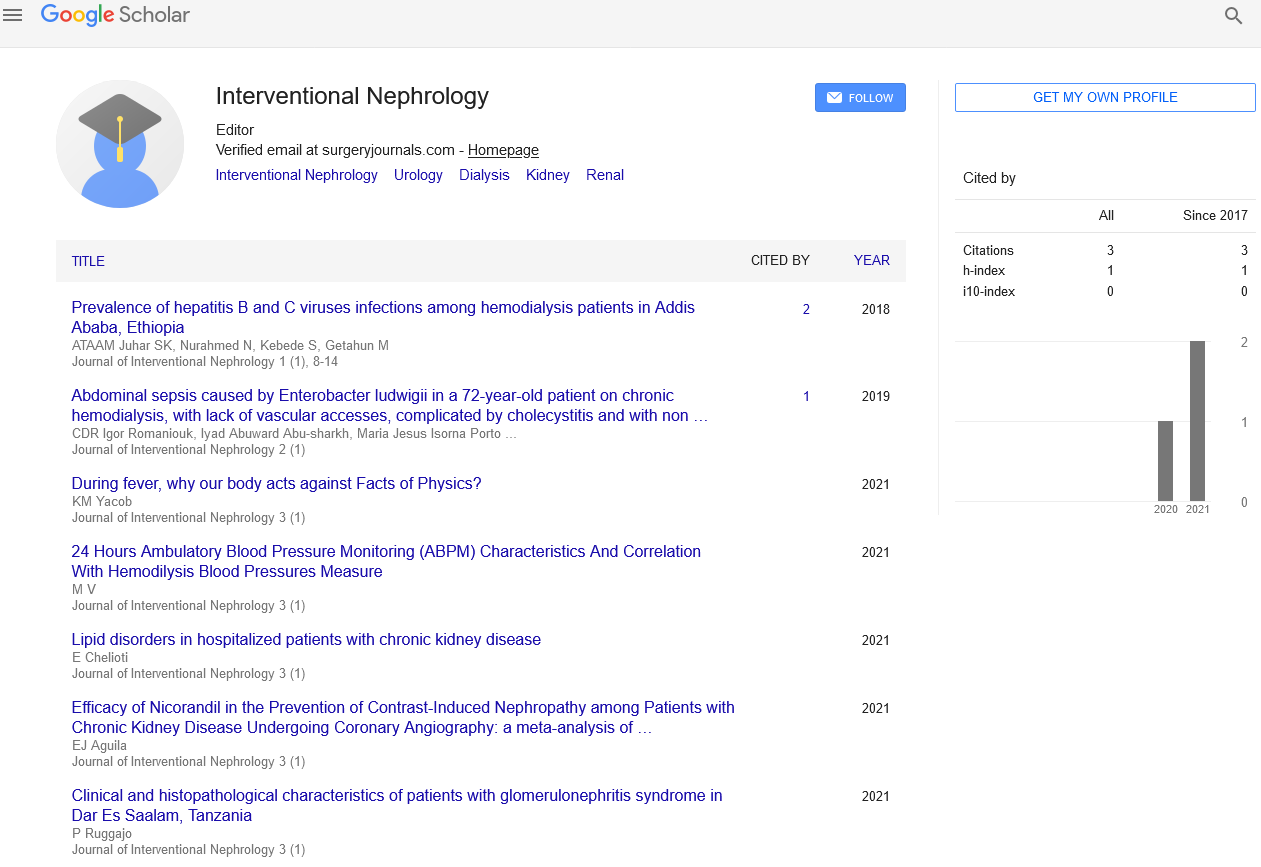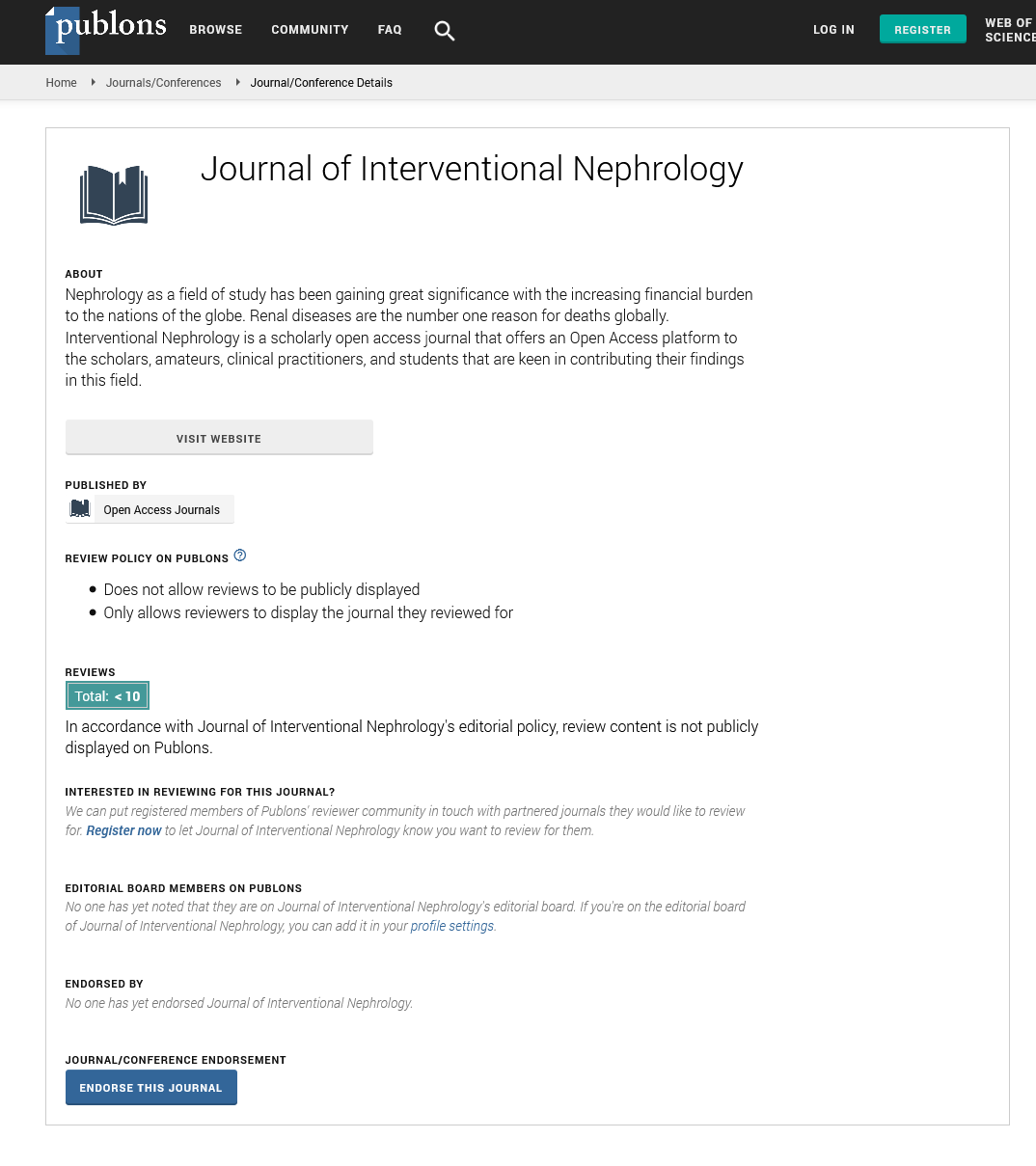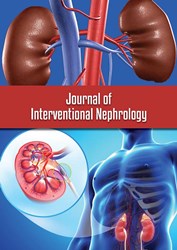Mini Review - Journal of Interventional Nephrology (2022) Volume 5, Issue 5
The Role of Tumour-Associated Macrophages in Nephron Cancer
Sofia Raffaele*
Pharmaceutical and Biomedical Sciences, University of Georgia, Athens, Georgia 30602
Pharmaceutical and Biomedical Sciences, University of Georgia, Athens, Georgia 30602
E-mail: yamansanem@yahoo.com
Received: 01-Oct-2022, Manuscript No. OAIN-22-77372 Editor assigned: 03-Oct-2022, PreQC No. OAIN-22- 77372 (PQ); Reviewed: 17-Oct-2022, QC No. OAIN-22-77372; Revised: 22- Oct-2022, Manuscript No. OAIN-22- 77372 (R); Published: 29-Oct-2022; DOI: 10.47532/oain.2022.5(5).58-61
Abstract
TAMs (tumour associated macrophages) are a crucial component of the tumour stroma. They begin as blood monocytes drawn to the tumour by chemokine’s and cytokines generated by the tumour cells, and under the guidance of the tumour microenvironment, they mature into a powerful population of cells that support the growth of the tumour. TAMs have been shown to directly increase angiogenesis and tumour cell growth. TAMs also promote tumour propagation by creating extracellular matrix remodelling enzymes and effectively block immune response by producing immunosuppressive cytokines. Numerous investigations were conducted to clarify the involvement of TAM in tumour development in renal cell carcinoma (RCC). It has been shown that a higher density of TAMs is linked to worse patient survival using the pan-macrophages marker CD68 and the type 2 macrophage (M2) markers CD163 and CD206 [1].
Several markers that are quite characteristic for type 1 macrophages (M1) were also defined, despite the fact that the majority of researches in RCC are focused on the M2 population. TNF, IL-1, IL-6, and CCL2 were shown to be produced by macrophages that were isolated from RCC tumours. Conclusion: RCC is a perfect example of a tumour with a hybrid TAM phenotype that exhibits both M1 and M2 characteristics. TAMs also appear to be a promising therapeutic target. Additional research is required to identify RCC- specific TAM indicators with high predictive value and/or that may be used for therapeutic targeting [2].
Introduction
The abnormal cell development in your kidney tissue is known as kidney cancer. These cells eventually gather into a mass known as a tumour. When cells undergo an alteration that causes them to divide uncontrollably, cancer develops. A malignant or cancerous tumour has the potential to spread to nearby tissues and crucial organs. Metastasis is the medical term for this. Two bean-shaped organs, each around the size of your fist, make up your kidneys. One kidney is situated on either side of your spine, and they are situated behind your abdominal organs. Renal cell carcinoma is the most prevalent form of kidney cancer in adults. There may be more, less typical kidney cancers [3]. A kidney cancer type known as Wilms’ tumour is more common in young children. Children are substantially less likely to get kidney cancer. However, every year in the US, 500 to 600 kids are found to have a Wilms tumour, a kind of kidney cancer. Kidney cancer seems to be becoming more common. The increased use of imaging methods like computed tomography (CT) scans might be one explanation for this. These screenings could unintentionally uncover more kidney tumours [4]. When the tumour is tiny and limited to the kidney, kidney cancer is frequently found early on. Most cases of kidney cancer occur in adults between the ages of 65 and 74. The illness strikes men twice as frequently as it strikes women. Additionally, it is more prevalent among Black and Native American communities [5].
A solid tumor’s malignant potential results from a complicated interplay between cancer cells and the stroma that supports them as well as from the transformation of individual cells. The latter consists of neutrophils, monocytes, and macrophages as well as fibroblasts, endothelial cells, and an inflammatory infiltrate that may be quite complicated. Together, these cells provide a microenvironment that promotes tumour development and invasion. Data accumulating to indicate the significance of stromal cells in tumour formation came from analysis of stromal cells using various histology methods or flow cytometry [6]. Numerous tumour stromal cell molecular markers with strong diagnostic and prognostic potential have been found. Since the discovery of their alternate modes of activation, tumour associated macrophages (TAMs) have received particular interest during the last three decades. Similar to other solid tumours, kidney tumours have a heterogeneous microenvironment made up of both cancerous and healthy stromal cells as well as a significant number of macrophages. The type of kidney cancer that occurs most frequently is renal cell carcinoma (RCC). More than 90% of kidney cancer cases are caused by it. The second-fastest increasing cancer in terms of incidence, behind prostate cancer, is kidney cancer, which is the tenth most common malignancy [7]. At age 70, kidney cancer incidence reaches its peak and is twice as common in men as it is in women. The frequency of kidney cancer has grown globally during the last 20 years. About 25% of kidney cancers have significant metastatic potential and are already metastatic when they are diagnosed. Metastatic kidney cancer has a bad prognosis. After the discovery of metastases, the life expectancy is just 10–13 months without specialised therapy. Cigarette smoking, obesity, persistent drug abuse, acquired cystic kidney disease, hypertension, and other hereditary conditions are all risk factors for the development of RCC. RCC treatment is hampered by late diagnosis and inadequate response to current medications. New diagnostic and therapeutic methods that go beyond the characteristics of cancer cells are therefore urgently needed. Clear cell renal cell carcinoma (60–85%) and renal papillary carcinoma (7–14%) are two types of kidney tumours classified today based on morphologic, cytogenetic, and molecular characteristics. Chromophobe renal cell carcinoma (4–10%), benign oncocytoma (2–5%), and collective duct cancer (1-2%) are three types of kidney tumours classified today based on intercalating cells of the collecting ducts of the kidney [8].
Kidney cancer staging
Finding the extent (stage) of the cancer is the next step when your doctor finds a kidney lesion that may be kidney cancer. Additional CT scans or other imaging examinations that your doctor deems necessary may be part of the staging process for kidney cancer.
Roman numbers from I to IV are used to denote the stages of kidney cancer, with the lowest stages suggesting kidney-confined malignancy. Stage IV indicates that the cancer has progressed to the lymph nodes or to other parts of the body and is regarded to be advanced [9].
Purpose of our Kidneys
• Detoxify (clean) our blood
• Balance fluids
• Maintain electrolyte levels (e .g ., sodium, potassium, calcium, magnesium, acid)
• Remove waste (as urine)
• Make hormones that help keep our blood pressure stable, make red blood cells and keep our bones strong
Treatment
• Removing the affected kidney (nephrectomy)
• Removing the tumor from the kidney (partial nephrectomy)
• Treatment to freeze cancer cells (cryoablation)
• Treatment to heat cancer cells (radiofrequency ablation)
• Surgery to remove as much of the kidney cancer as possible
• Targeted therapy
• Immunotherapy
• Radiation therapy
• Clinical trials
Tumor Associated Macrophages Origin and Function
For their detrimental role in the formation of tumours, their primary functional features relating to immune response suppression, extracellular matrix remodelling, and angiogenesis promotion continue to be the most significant. Although the M1/M2 dichotomy is currently being rethought, we will continue to utilise this nomenclature in this review for the purpose of simplicity and clarity. To complement the Th1/Th2 paradigm, the idea of two different kinds of macrophage activation was proposed around the turn of the 20th century. M1, also known as classically activated macrophages, are distinguished by the expression of opsonic receptors (FcRI, II, and III) and bactericidal effector molecules. The Th1 cytokine IFN is an example of an endogenous inflammatory stimulus. Exogenous inflammatory stimuli include lipopolysaccharide (LPS) and other bacterial products. By releasing proinflammatory cytokines, M1 promotes inflammatory responses [10]. The expression of nonopsonic receptors, such as the macrophage mannose receptor CD163 and hMARCO, the upregulation of Th2-associated cytokines and chemokines, such as IL1ra or AMAC-1, and the production of extracellular matrix substances and ECM remodelling factors are all characteristics of M2, or alternatively activated macrophages (fibronectin, tenascin-c, and MMP12). M2 resemble tumorassociated macrophages in both their markers and functional makeup. M2 has characteristics that promote the growth of the tumour, such as the promotion of angiogenesis, which is accomplished through the production of angiogenic agents such cytokines and matrix metalloproteinases. Degradation of the extracellular matrix, capillary endothelial cell migration and proliferation, and mature capillary differentiation are all necessary for extensive angiogenesis. Newly generated capillaries provide metastatic cells a way to depart the tumour and enter the bloodstream while supplying the tumour with enough nutrition and oxygen[11]. MMPs, or matrix metalloproteinases, are essential for cell invasion. More than 20 enzymes make up the family of matrix metalloproteinases, which is capable of degrading the extracellular matrix’s protein constituents. Overexpression of MMPs is associated with increased invasiveness and a poor prognosis in nearly all tumour forms. Recent studies demonstrate that MMPs expression increases in kidney malignancies, and that this rise is useful for prognostication. In RCC, for instance, the expression of the MMP-2 protein is substantially correlated with the histological grade, TNM stage, tumour size, and LNM, indicating that the MMP2 protein may act as a biological marker for the prognosis in RCC. The intricate process of ECM remodelling entails a number of enzyme systems. The plasminogen activation system is second in importance to MMPs for tumour pathogenesis[12].
The conclusion that urokinase-like plasminogen activator (uPA) and its regulators are actively engaged in the creation of the metastatic phenotype of many tumour types is supported by a large number of clinical and experimental researches. A soluble serine protease called uPA interacts to the uPAR on its membrane receptor to activate its proteolytic activity. The proteolytic cleavage of plasminogen to produce plasmin is the primary function of uPA. The proteolytic cleavage of plasminogen to produce plasmin is the primary function of uPA. Conversely, plasmin has a wide range of substrates that it may cleave, including laminin, fibrin, fibronectin, and vitronectin, which are all ECM proteins. The growth factors SF/HGF, beta FGF, and TGF beta are activated by plasmin by proteolytic cleavage of their latent forms, just as MMPs. Collagenase is activated by the cleavage of procollagenase. These uPA system functions all support tumour invasion and proliferation. Numerous tumour forms have been shown to produce uPA activation-related proteins more often, and higher levels of uPA activity are associated with worse disease prognoses [13].
Additional support for the significance of uPA for tumour development came from experimental models. It has been shown that uPA activity inhibition prevents tumour invasion and metastasis. It has been shown that TAMs express uPA and its receptor in breast and other tumour types, where they play a role in the ECM’s breakdown, which is required for the development of new blood vessels. The density of blood vessels in tumours and the unfavourable prognosis for the condition were associated with the degree of uPA receptor expression. High levels of uPA and uPAR in tumour tissue extracts are linked to a considerably lower life time for individuals with ccRCC even when they do not have distant metastases in the kidney. These findings show the significance of uPA controlled by tumorassociated macrophages in the remodelling of the tumor’s vascular system [14].
Conclusion
It is widely known that tumor-associated macrophages play a key role in the pathophysiology of RCC. To provide new and efficient diagnostic or treatment techniques for RCC, further research is required. Too far, measuring macrophages in RCC has mostly relied on classic M2 markers (CD206, CD163) or the pan-macrophage marker CD68. However, as CD68 was shown to be expressed by ccRCC cells, using these markers for a straightforward quantification of macrophages is insufficient for predicting the clinical course of the illness and may potentially be deceptive. From the variety of existing M2 markers, more TAM markers should be researched [15]. These include tenascin-C, FXIIIa, fibronectin, IGH3, Stabilin-1, YKL39, SI-CLP, and others. Combinations of these markers may be used to create a unique diagnostic strategy with excellent predictive power. Furthermore, it is crucial to consider the region of the tumour where TAM analysis is conducted. It was explained that the prognostic usefulness of analysing macrophages in various tumour regions varies and that they may express various markers. The development of current therapeutic targeting tactics for TAMs follows a pattern similar to that of diagnostic methods. They use markers like CD204, CD206, or folate receptor beta, which aren’t highly specific for macrophages that are linked with tumours and are much less so for a particular kind of tumour. For the purpose of finding TAM indicators that are unique to tumours, screening tests must be carried out. The results of these screens will make it possible to create targeted methods for reprogramming or eradicating TAM populations that promote tumours [16].
References
- Garcia JA, Cowey C L, Godley PA. Renal cell carcinoma. Current Opinion in Oncology. 21, 266– 271 (2009).
- Toge H, Inagaki T, Kojimoto Y et al. Angiogenesis in renal cell carcinoma: the role of tumor associated macrophages: Original Article: Clinical Investigation. International Journal of Urology. 16, 801– 807 (2009).
- Mantovani A, Bottazzi B, Colotta F et al. The origin and function of tumor-associated macrophages. Immunology Today. 13, 265–270 (1992).
- Daurkin I, Eruslanov E, Stoffs T et al. Tumor-associated macrophages mediate immunosuppression in the renal cancer microenvironment by activating the 15-lipoxygenase-2 pathway. Cancer Research. 71, 6400–6409 (2011).
- Komohara Y, Fujiwara Y, Ohnishi K et al. Tumorassociated macrophages: potential therapeutic targets for anticancer therapy. Advanced Drug Delivery Reviews. 99, 180–185 (2016).
- Foekens JA, Peters HA, Look MP et al. The urokinase system of plasminogen activation and prognosis in 2780 breast cancer patients. Cancer Research. 60, 636–643 (2000).
- Hildenbrand R, Dilger I, Horlin A et al. Urokinase and macrophages in tumour angiogenesis. British Journal of Cancer. 72: 818–823 (1995).
- Gordon S. Alternative activation of macrophages. Nature Reviews Immunology.3, 23–35 (2003).
- Liu Q, Zhang GW, Zhu CY, et al. Clinicopathological significance of matrix metalloproteinase 2 protein expression in patients with renal cell carcinoma: a case-control study and meta-analysis. Cancer Biomarkers. 16, 281–289 (2016).
- Chang C, Werb Z. The many faces of metalloproteases: cell growth, invasion, angiogenesis and metastasis. Trends in Cell Biology. 11, S37–S43 (2001).
- Gratchev A, Kzhyshkowska J, Utikal J et al. Interleukin-4 and dexamethasone counterregulate extracellular matrix remodelling and phagocytosis in type-2 macrophages. Scandinavian Journal of Immunology. 61, 10–17 (2005).
- Schaer DJ, Boretti FS, Hongegger A et al. Molecular cloning and characterization of the mouse CD163 homologue, a highly glucocorticoid-inducible member of the scavenger receptor cysteine-rich family. Immunogenetics. 53, 170–177 (2001).
- Goerdt S, Politz O, Schledzewski K et al. Alternative versus classical activation of macrophages. Pathobiology. 67, 222–226 (1999).
- Vogelzang, Nicholas J, Walter MS. Kidney cancer.The Lancet. 352, 1691-1696 (1998).
- Chow, Wong-Ho, Linda MD, et al. Epidemiology and risk factors for kidney cancer.Nature Reviews Urology.7.5, 245-257 (2010).
- Motzer, Robert J, et al. Kidney cancer. Journal of the National Comprehensive Cancer Network. 7.6, 618-630 (2009).
Indexed at, Google Scholar, Crossref
Indexed at, Google Scholar, Crossref
Indexed at, Google Scholar, Crossref
Indexed at, Google Scholar, Crossref
Indexed at, Google Scholar, Crossref
Indexed at, Google Scholar, Crossref
Indexed at, Google Scholar, Crossref
Indexed at, Google Scholar, Crossref
Indexed at, Google Scholar, Crossref
Indexed at, Google Scholar, Crossref
Indexed at, Google Scholar, Crossref
Indexed at, Google Scholar, Crossref


